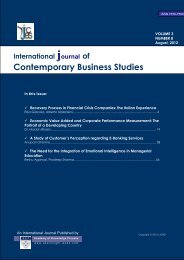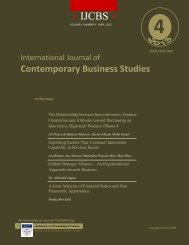Contemporary Business Studies - Academy of Knowledge Process ...
Contemporary Business Studies - Academy of Knowledge Process ...
Contemporary Business Studies - Academy of Knowledge Process ...
You also want an ePaper? Increase the reach of your titles
YUMPU automatically turns print PDFs into web optimized ePapers that Google loves.
International Journal <strong>of</strong> <strong>Contemporary</strong> <strong>Business</strong> <strong>Studies</strong><br />
Vol: 3, No: 1. January, 2012 ISSN 2156-7506<br />
Available online at http://www.akpinsight.webs.com<br />
uncertainty. When Bayesian networks were first introduced, assigning the full probability distributions<br />
manually was time intensive. Solving a Bayesian network with a considerable number <strong>of</strong> nodes is known<br />
to be a nondeterministic polynomial time hard [NP hard] problem (Dagum and Luby, 1993). However,<br />
significant advancements in computational capability along with the development <strong>of</strong> heuristic search<br />
techniques to find events with the highest probability have enhanced the development and understanding<br />
<strong>of</strong> Bayesian networks. Correspondingly, the Bayesian computational concept has become an emergent<br />
tool for a wide range <strong>of</strong> risk management applications (Cowell et al, 2007). The methodology has been<br />
shown to be especially useful when information about past and/or current situations is vague, incomplete,<br />
conflicting, and uncertain.<br />
Pai et al (2003) were among the first researchers to analyze supply chain risks using Bayesian networks.<br />
Their study examined the risk pr<strong>of</strong>ile associated with a US Department <strong>of</strong> Defense (DoD) supply chain<br />
for trinitrotoluene (TNT). The supply chain was comprised <strong>of</strong> TNT recovery plants, storage facilities, and<br />
ammunition depots. Using Bayesian networks, the researchers were able to establish risk factors and<br />
acceptable risk limits for all assets contained in the DoD supply chain. Bayesian networks have also been<br />
used to conduct diagnostics (Kauffmann et al, 2002; Kao et al, 2005), cost optimization studies<br />
(Narayanan et al, 2005), and flexibility analysis (Wu, 2005; Milner and Kouvelis, 2005) in supply chains.<br />
Since the work <strong>of</strong> Pai et al (2003), researchers have continued to explore the use <strong>of</strong> Bayesian networks to<br />
analyze and manage supply chain risks. For example, there have been a number <strong>of</strong> studies which<br />
examine the use <strong>of</strong> Bayesian networks as part <strong>of</strong> a decision support system to manage such risks (Li and<br />
Chandra, 2007; Meixell et al, 2008; Shevtshenko and Wang, 2009; Makris et al, 2001; Taskin and Lodree,<br />
2011). <strong>Studies</strong> by Tomlin (2009) and Chen et al (2010) demonstrate how Bayesian networks can be used<br />
to manage supply chain uncertainty. The integration <strong>of</strong> Bayesian networks into supply chain forecasting<br />
methodologies to mitigate risks has also been examined by several researchers (Yelland, 2010; Yelland et<br />
al, 2010; Rahman et al, 2011). Lockamy and McCormack (2009) conducted a study which uses Bayesian<br />
networks to examine operational risks in supply chains. The authors have also used these networks to<br />
analyze outsourcing risks in supply chains (Lockamy and McCormack, 2010). Finally, Lockamy (2011)<br />
has developed a methodology for benchmarking supplier risks using Bayesian networks.<br />
This research study contributes to the current body <strong>of</strong> supply chain management literature by introducing<br />
a methodology for evaluating network risks in supply chains. The methodology also includes an<br />
assessment <strong>of</strong> the potential revenue impact a supplier can have on an organization as measured by valueat-risk<br />
(VAR). The methodology in this study is <strong>of</strong>fered as a tool to assist supply chain managers in the<br />
formulation <strong>of</strong> strategies and tactics designed to mitigate supply chain risks.<br />
4.2Assessment Model<br />
An assessment model developed by Handfield and McCormack (2007) was used to evaluate the risk <strong>of</strong><br />
each supplier. This model incorporates data from several sources to provide a 360-degree view <strong>of</strong> a<br />
supplier's risk pr<strong>of</strong>ile. The risk assessment model is presented in Figure 1. A potential challenge regarding<br />
the use <strong>of</strong> the assessment model is the need for a detailed review <strong>of</strong> data furnished by suppliers. Such<br />
reviews can be costly and time consuming, and therefore are usually limited to the firm's strategic<br />
suppliers. However, well designed, qualitative self- reporting can be very cost effective. As in the case <strong>of</strong><br />
this study, each supplier was required to answer an online multiple choice survey that takes less than 30<br />
minutes to complete. In addition, given the large number <strong>of</strong> suppliers in many supply chains, the buyers<br />
or category managers <strong>of</strong>ten do not know every detail about each supplier, thus making self-reporting by<br />
suppliers a necessity. With these qualitative indicators, it is also feasible and affordable to assess several<br />
tiers in the supply network, consequently making the network risk pr<strong>of</strong>ile broad and deep. The risk<br />
assessment model identifies and quantifies the risk <strong>of</strong> a supply disruption using a framework that<br />
describes the attributes <strong>of</strong> suppliers, their relationships, and their interactions with the organization<br />
performing the assessment.<br />
10<br />
Copyright © 2012. <strong>Academy</strong> <strong>of</strong> <strong>Knowledge</strong> <strong>Process</strong>
















